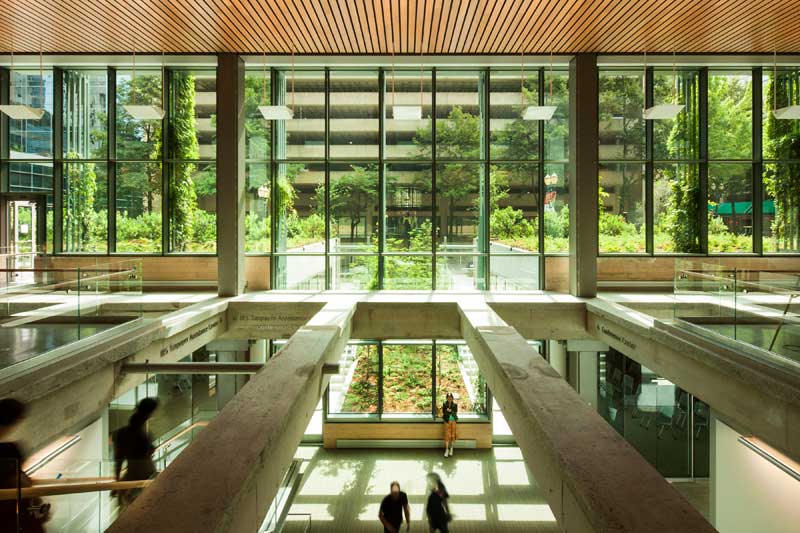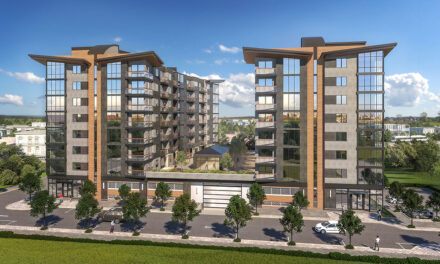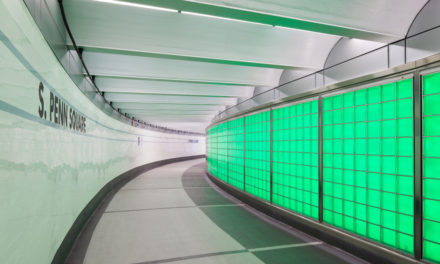The Edith Green-Wendell Wyatt Federal Building in Portland, Ore., has been named the winner of the American Institute of Architects Top Ten Plus award for demonstrating “quantifiable metrics demonstrating the true impact the sustainable design has achieved.”
The award was announced by the AIA and its Committee on the Environment (COTE). The U.S. General Services Administration building was selected in 2014 as a recipient of the AIA/COTE Top Ten Project Award program. The designers are SERA Architects and Cutler Anderson Architects,
In announcing the “Top Ten Plus” winner, the AIA added a jab at congressional action aimed at derailing conservation requirements for federal buildings, voicing “staunch opposition” to provisions “buried” in a just-passed Senate energy bill.
“We consider this both counterproductive and a contradiction to the main premise in the energy bill,” the AIA said in a statement condemning the measure. “Bluntly, it makes no sense policy-wise and capitulates to special interests of the fossil fuel lobby.”
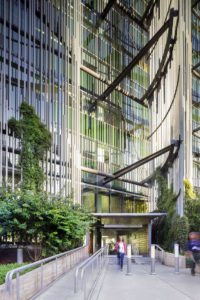
The vertical reeds provide occupants with a connection to nature and support habitat. Credit: Nic Lehoux
The Top Ten Plus award-winning project, the AIA said, “regardless of your feelings on or coverage of Congressional matters, should stand as excellent example of how sustainable design applications have real-world, bottom-line focused benefits.”
The full announcement on the Senate action: Architects Denounce Senate Vote Killing Energy Conservation Requirements for Federal Buildings.
Impressive sustainability credentials
The Green-Wyatt structure is an 18-story, 512,474-square-foot office tower in downtown Portland. Originally built in 1974, the building received funding from the American Recovery and Reinvestment Act to undergo a major renovation to replace outdated equipment and systems. This funding stipulated the project must meet the stringent energy and water conservation requirements of the Energy Independence and Security Act (EISA).
Working with Howard S. Wright Construction, the design team was able to deliver the project 10 months early, saving taxpayers more than $900,000 in the process.
The building is reported to have exceeded projected energy and water-saving goals; gas and electrical utility bills demonstrate a 45-percent energy savings in the first two years of use compared to a building built to code; and a water model predicted the building would harvest approximately 540,000 gallons of water annually—a 60 percent reduction in water use compared to a typical building. But in the first two years of use, the actual rainwater collected annually was 626,544 gallons, or a 65 percent reduction in water use.
Other metrics:
- The renovated building uses 55% less energy than the original structure
- By maintaining a central location downtown, an estimated 85% percent of occupants are not reliant on single-occupancy vehicles for transportation.
- The radiant heating and cooling system resulted in a projected lifecycle cost reduction of $2 million compared to traditional Variable Air Volume Air Systems.
- The building boasts an occupant satisfaction rating of 75%.
More details on the design elements and images are available here. Highlights from project team members are reviewed in this video.
In its fourth year, the Top Ten Plus award recognizes one past AIA COTE Top Ten Project Award recipient which has quantifiable metrics demonstrating the true impact the sustainable design has achieved.
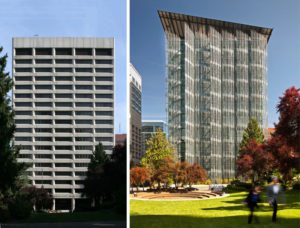
The original 1974 building (right) and today, following its high-efficiency makeover. Credit: SERA (left) and Nic Lehoux (right)
“We were tasked with converting an aging energy hog into one of GSA’s highest-performing buildings,” said Don Eggleston, AIA, principal at SERA Architects.
From an initial building analysis, it was determined that for seismic safety, the precast concrete exterior would need to be removed. Energy studies led to a number of solutions, including a blast-resistant glass curtain wall, exterior shading and reflective elements and a highly-efficient hydronic heating and cooling system inside.
“These creative design solutions not only reduced utility costs, but also freed up more than 30,000 square feet of rentable space that enabled a much greater ROI for the GSA’s investment in this property,” Eggleston said.
“We’re proud that this GSA cornerstone building is one of the most efficient office buildings in the country,” said Kimberly Gray, GSA director of the Facilities Management Division. “Our tenants regularly give us feedback about how they enjoy all of the building features, especially the increased exposure to daylight throughout.”
The COTE Awards Jury added this comment: “This project transforms a generic concrete office building into a high-performance, environmentally responsive, comfortable place to work. This sets a great precedent for re-use and upgrade, and demonstrates the potential for creative, green re-use projects.”

